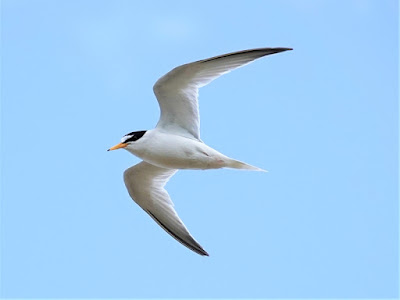Here are a few images. An un-forecast shower gave me a soaking on the walk out. Presumably as a result the camera gave me a series of incomprehensible error messages that, thankfully, did not seem to affect the results.
Starting with a randomly chosen set of flying birds. Black-tipped yellow bill and white forehead on otherwise black cap characterises this species.
Nearly there after a long trek along a boardwalk from the village.
Starting with a randomly chosen set of flying birds. Black-tipped yellow bill and white forehead on otherwise black cap characterises this species.
One carrying a fish.
And another. A single fish is carried, always held at the head end.
Just visible is the ring on the left leg. All the birds are ringed and regularly monitored.
The ring perhaps more visible here. A few battered feathers in the wings of this one.
This species, like many terns, can be quite feisty if you get too close. It seems a few birds are nesting in the dunes and make their presence known.
Another passing.
And another.
One going the other way for a change.
They are noisy too, though walk a 100 yards / metres away and they are barely audible.
Another going the other way.
Two adults, one with a fish, stand on the sand in the colony. A few boxes are provided for nest (most nests are on the sand). Two juveniles can be seen at the entrance to the box.
A Grey Heron.
A few pairs of Oystercatchers share the sand with the terns.
Meadow Pipits display in the dunes and...
...hunt in the grassy areas for insects...
...to feed to their brood.
A battered and faded Red Admiral butterfly (Vanessa atalanta)
In the dunes were many Pyramidal Orchid (Anacamptis pyramidalis) here with some spiky Sea Holly (Eryngium planum) just visible.





































